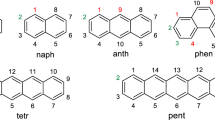Abstract
In the framework of the Hückel MO approximation, the differences in total binding energy between a given molecule and the corresponding distorted Kekulé-type structure are calculated for a variety of benzenoid hydrocarbons. The total binding energy is assumed to be given by the sum of the π-electron and σ-electron binding energies. It is shown that there is a good linear relationship between the calculated differences in total binding energy and the π-electron delocalization energies (DE) as obtained by using the simple Hückel MO method. This provides a physical basis for the use of the π-electron DE as a theoretical index to the empirical resonance energy (RE). Further, by examining the changes in π-electron binding energy between a given molecule and the corresponding distorted Kekulé-type structure, it is concluded that in benzenoid hydrocarbons the main contributor to the RE is not the π-electron DE but the compressional energy of σ bonds.
Similar content being viewed by others
References
Streitwieser A Jr (1961) Molecular orbital theory for organic chemists. Wiley, NY, p 203;
Salem L (1966) The molecular orbital theory of conjugated systems. Benjamin, NY, p 97
Epiotis ND (1984) Nouv J Chim 8:11
Shaik SS, Hiberty PC, Lefour JM, Obanessian G (1987) J Am Chem Soc 109:363;
Shaik SS, Hiberty PC, Obanessian G, Lefour JM (1988) J Phys Chem 92:5086
Hiberty PC, Shaik SS, Obanessian G, Lefour JM (1986) J Org Chem 51:3908
Cooper DL, Garratt J, Raimondi M (1986) Nature 323:699
Jug K, Köster AM (1990) J Am Chem Soc 112:6772
Hiberty PC, Shaik SS, Lefour JM, Obanessian G (1985) J Org Chem 50:4657
Dewar MJS, Schmeising HW (1959) Tetrahedron 5:166
Longuet-Higgins HC, Salem L (1959) Proc Roy Soc London A251:172;
Salem L, Longuet-Higgins HC (1960) Proc Roy Soc London A255:435
Nakajima T (1965) Bull Chem Soc Jpn 38:83
Yamaguchi H, Nakajima T (1974) Bull Chem Soc Jpn 47:1898
Kataoka M, Nakajima T (1987) J Org Chem 52:2323
Schaad LJ, Hess BA Jr (1972) J Am Chem Soc 94:3068
Dewar MJS, Gleicher GJ (1965) J Am Chem Soc 87:685, 692;
Dewar MJS, de Llano C (1969) J Am Chem Soc 91: 789
Baird NC (1986) J Org Chem 51:3907
Author information
Authors and Affiliations
Rights and permissions
About this article
Cite this article
Nakajima, T., Kataoka, M. A new theoretical approach to the empirical resonance energies of the aromatic hydrocarbons. Theoret. Chim. Acta 85, 27–31 (1993). https://doi.org/10.1007/BF01374574
Received:
Accepted:
Issue Date:
DOI: https://doi.org/10.1007/BF01374574




